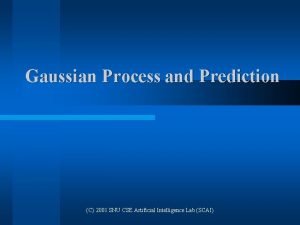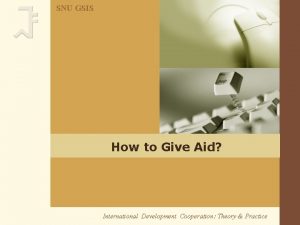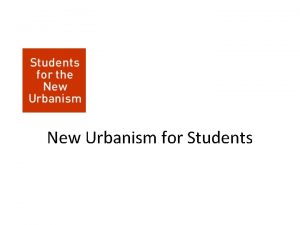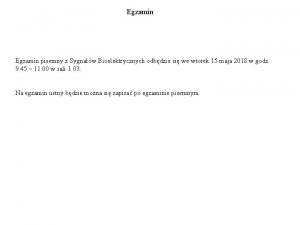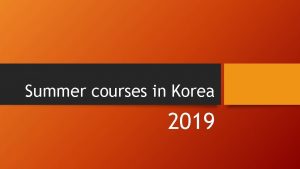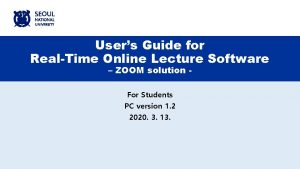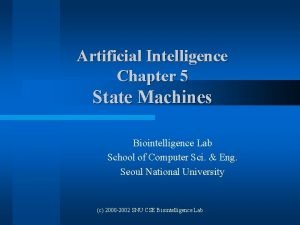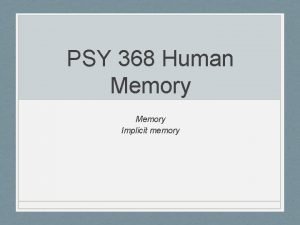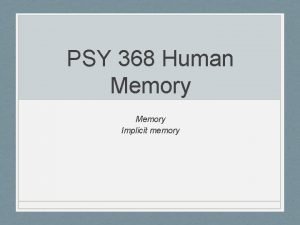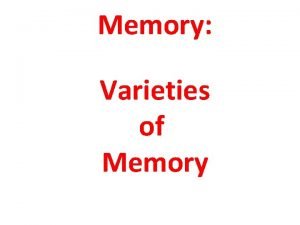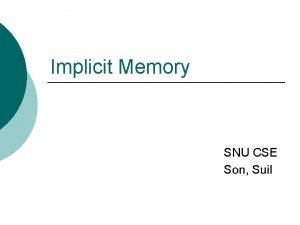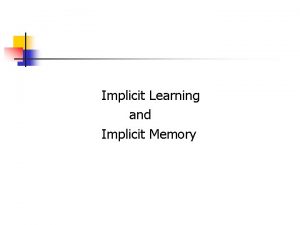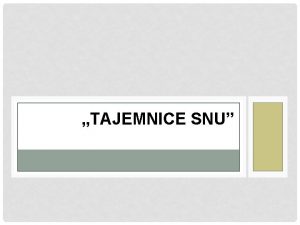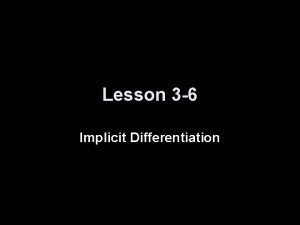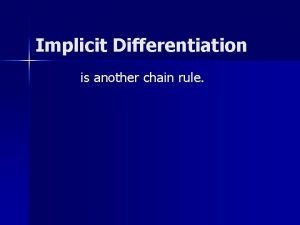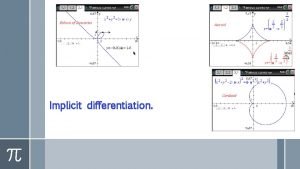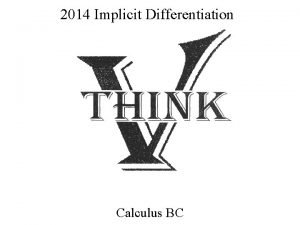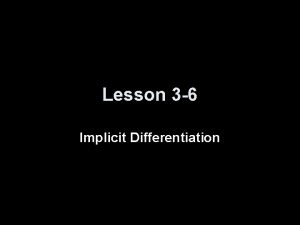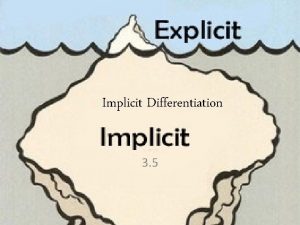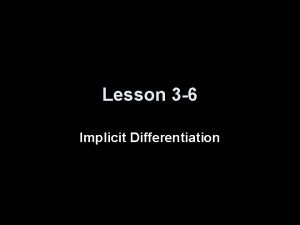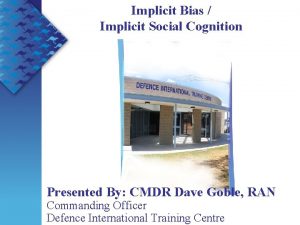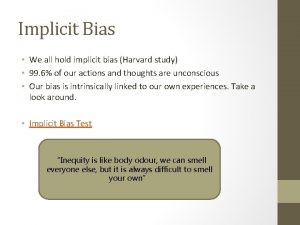Implicit Memory SNU CSE Son Suil Contents Question

















- Slides: 17

Implicit Memory SNU CSE Son, Suil

Contents ¡ ¡ ¡ Question implicit memory vs. explicit memory Various ways of Experiment Can learning occur without awareness ? Evidence of implicit memory (by experimental dissociation) Theoretical accounts of implicit memory l l The Activation View Multiple Memory Systems Transfer Appropriate Processing The Bias View

Question ¡ ¡ ¡ Q 1 : What is the main difference between implicit memory and explicit memory ? Q 2 : How can we know that implicit memory and explicit memory are different ? Q 3 : What are the good point and the weak point of 4 accounts of implicit memory ?

Implicit Memory vs. Explicit Memory ¡ Implicit memory is memory without awareness. l ¡ Explicit memory is memory with awareness. l ¡ Listening to music while doing other work. Preparing to exam We can discriminate these by experiment. (learning test)

Various ways of Experiment Test Instructions – PHASE II Study (Learning) Instructions - PHASE I Indirect Direct Incidental Cell 1 Cell 2 Intentional Cell 3 Cell 4 * Incidental vs. intentional – learning instruction * Indirect vs. direct – testing method * Implicit vs. explicit – type of memory used Cell 1 : subjects do not intentionally learn the testing items and are not aware of the relationship between the test and the study (learning) phase. So they do not try to recall the items on test. (usually implicit memory test) Cell 2 : subjects do not intentionally learn the testing items but on testing phase, they are instructed to recall the items just studied. Cell 3 : subjects instructed to memorize items on study phase, but they don’t try to memorize directly the items met previous phase. Cell 4 : subjects are asked to study items and on testing phase, are asked to recall the items just studied test. (usually explicit memory test)

Can learning occur without awareness? – 1 S ¡ Markovian artificial grammar test l ¡ l P Conclusion : l Learning can indeed occur in the absence of awareness S P V S 3 S 1 Both group were tested to identify words whether they are grammatical or not Group 1 was more accurate, but they can not verbalize what they learned S 4 S 1 X Result : l ¡ Group 1 : Learn Markovian grammar Group 2 : Does not Learn Markovian grammar S 2 S 1 Test l ¡ T intentional learning and direct test (Cell 4) Learning l ¡ X Type of Experiment l ¡ By A. S. Reber. S 5 S 1 S 6 S 1 V T LETTERES GRAMMARTICAL ? TXS O PXS X TSPS X TXXVV O

Can learning occur without awareness? – 2 ¡ Type of Experiment l ¡ Learning l Test l l l ¡ Identify the sequence is old or new. (the pattern was shown previously or not) Fast presentation rate – can not use knowledge Slow presentation rate – can use knowledge Result l ¡ Pressing a sequence of dots appear in one of four locations (ex. 1 -2 -2 -1, 4 -3 -1 -3, …) For slow representation rate, subject were able to distinguish between old and new sequences Conclusion l Learning can occur in the absence of awareness Old Mean Confidence Rating ¡ incidental learning and direct test (Cell 2) New Fast Slow

Experimental Dissociations ¡ Learning can occur without awareness but can we say that there is confidently implicit memory? l ¡ We need to show that implicit memory is different from other memory (explicit memory) When experimental method is different and the test result is also different, then we can say that there is dissociation. Group 1 Group 2 Intentional direct Incidental Different learning instruction indirect Different testing instruction Different result 1 2 3 4

Dissociation experiment 1 (Tulving, Schacter, Stark) ¡ Phase I : learn a list of 96 words l ¡ Phase II-1 : 1 hour later l l ¡ Phase II-2 : 7 days later l ¡ Same test for another 48 word Analysis of the result l ¡ Word-fragment completion test (indirect test) ¡ Completing words in mind Recognition test (direct test) ¡ Identify the word was shown or not previously Better result for recognition test on 1 Hour later, is repetition priming obtained previous intentional learning. Conclusion : l l Probability of Response l Group 1 : just playing with words (incidental learning) Group 2 : just playing with words (incidental learning, but more key words) A B 1 Hour 7 Days A. Recognition (direct test) B. Fragment Completion (indirect test) There is difference between indirect test and direct test There are implicit memory and explicit memory * Repetition priming : Processing something as second time benefits from its having been processed previously

Dissociation experiment 2 (Graf, Schacter) ¡ ¡ ¡ Phase I : studied word pair Phase III : Test l l l Group 1, 2 - Direct test : Asked to complete the stem with the originally studied word. Group 1, 2 - Indirect test : word-fragment completion with the first word that came to mind) Group 3. Only Phase III direct, indirect test (Base Line) Phase II Tested On Interference Control (Group 1) A-B C-D A-B Experimental (Group 2) A-B A-D A-B RI (Retroactive Interference) Control (Group 1) C-D A-B Experimental (Group 2) A-D A-B PI (Proactive Interference) RI (Retroactive Interference) Test Type ¡ Control (Group 1) Experimental (Group 2) Direct . 55 . 40 . 67 . 45 Indirect . 34 . 32 . 35 Analysis of the result l ¡ PI (Proactive Interference) RI and PI affected direct tests of memory but did not affect indirect tests Conclusion : l l There is dissociation between indirect test and direct test. There are implicit memory and explicit memory

Theoretical accounts of implicit memory The Activation View ¡ Multiple Memory Systems ¡ Transfer Appropriate Processing ¡ The Bias View ¡

The Activation View Indirect test is attributable to the temporary activation of preexisting representations. ¡ KEY WORD : Temporary ¡ The least popular of the four views ¡ Weak Point ¡ l can not explain long time effects

Multiple Memory Systems ¡ ¡ Many dissociations between direct and indirect tests of memory arise because the tests tap different underlying memory systems. The assumption of multiple memory system. System Other Name Subsystems Characteristics Procedural Nondeclarative Motor skills Nonconscious operation (indirect) Cognitive skills Simple conditioning Simple associative learning Perceptual representation Nondeclarative Visual word form Auditroy word form Structural description Primary memory Working memory Visual Auditory Semantic Generic Spatial Factual Relational Knowledge Episodic Personal Autobiographical Event memory Conscious operation (direct)

Transfer Appropriate Processing ¡ 4 assumption l l ¡ A given type of processing will lead to better memory performance if it is appropriate for the particular test Direct and indirect tests of memory typically require different retrieval operation Most indirect tests rely primarily on perceptual processing. ¡ Data driven Most direct tests rely primarily on the encoded meaning of concepts ¡ Conceptually driven Direct/Data Driven , Indirect/Data Driven , Direct/ Conceptually Driven , Indirect/Conceptually Driven Test l l Not multiple memory system (Direct vs. Indirect) Two Data Driven Test Result is Better Auditory Visual Direct/Data Driven Two Direct Better Direct/Conceptually Driven Multiple System View Predict Indirect/Data Driven Indirect/Conceptually Driven Two Data Driven Better V Transfer Appropriate Processing Predict V Result V

The Bias View ¡ ¡ Other 3 views can not explain quite well especially the repetition priming effects. Prior presentation of an item can bias subsequent processing of the item on later presentations l ¡ Bias entails both cost and benefits l l ¡ One is likely to interpret a stimulus in the same way as you have interpreted it in the past Cost : There will be an advantage if prior processing is appropriate for the current task Benefits : There will be a disadvantage if prior processing is inappropriate for the current task. Experiments : 2. Second See ambiguous woman 1. First See one of old woman and young woman 3. People are more likely to interpret the ambiguous picture as the same person as the unambiguous picture 1. First See Old Woman Young Woman 2. Second See Ambiguous -> Old Woman Ambiguous -> Young Woman

Summary ¡ ¡ ¡ Implicit memory is memory without awareness. There are various ways of experiment Learning can occur without awareness. We can say that Implicit memory is different memory from explicit memory by experimental dissociations. There is 4 main accounts for implicit memory

The End ¡ Thank you
 Snu cse
Snu cse Implicit and explicit memory
Implicit and explicit memory Costa 3 level questions
Costa 3 level questions Utjeha kose
Utjeha kose Snu financial aid
Snu financial aid What is snu
What is snu Fazy snu wykres
Fazy snu wykres Snu summer school
Snu summer school Snu
Snu Math snu
Math snu Zoom snu
Zoom snu Snu gsis
Snu gsis Snu blackboard
Snu blackboard Types of memory in psychology
Types of memory in psychology Implicit vs explicit memory
Implicit vs explicit memory Implicit memory
Implicit memory Explicit memory psychology example
Explicit memory psychology example Implicit vs explicit memory
Implicit vs explicit memory
